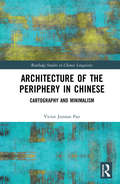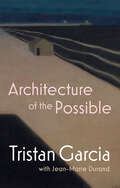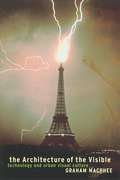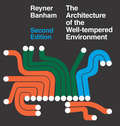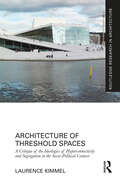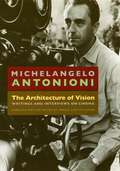- Table View
- List View
The Architecture Of The Mind: Massive Modularity And The Flexibility Of Thought
by Peter CarruthersThis book is a comprehensive development and defense of one of the guiding assumptions of evolutionary psychology: that the human mind is composed of a large number of semi-independent modules. The Architecture of the Mind has three main goals. One is to argue for massive mental modularity. Another is to answer a 'How possibly?' challenge to any such approach. The first part of the book lays out the positive case supporting massive modularity. It also outlines how the thesis should best be developed, and articulates the notion of 'module' that is in question. Then the second part of the book takes up the challenge of explaining how the sorts of flexibility and creativity that are distinctive of the human mind could possibly be grounded in the operations of a massive number of modules. Peter Carruthers's third aim is to show how the various components of the mind are likely to be linked and interact with one another - indeed, this is crucial to demonstrating how the human mind, together with its familiar capacities, can be underpinned by a massively modular set of mechanisms. He outlines and defends the basic framework of a perception / belief / desire / planning / motor-control architecture, as well as detailing the likely components and their modes of connectivity. Many specific claims about the place within this architecture of natural language, of a mind-reading system, and others are explained and motivated. A number of novel proposals are made in the course of these discussions, one of which is that creative human thought depends upon a prior kind of creativity of action. Written with unusual clarity and directness, and surveying an extensive range of research in cognitive science, this book will be essential reading for anyone with an interest in the nature and organization of the mind.
An Architecture of the Mind: A Psychological Foundation for the Science of Everyday Life
by Brendan Markey-TowlerAn Architecture of the Mind proposes a mathematically logical and rigorous theory of lived experience, and a comprehensive and coherent theory of psychology. It is also remarkably simple. Building on the core proposition that the mind is a network structure, it proposes a theory of the psychological process as operating within and upon that structure, and a theory of behaviour as determined by that process. The theory presents a view of the mind which reveals a new perspective on the process of reasoning in thinking and how it may coexist with processes more akin to simple rule-following and computation. It allows us to understand the role and influence of social influences in the psychological process by revealing their role in and influence on mental networks. It reveals the place of motivations in the psyche as complexes in mental networks from whence aesthetics, preference and value judgements arise and demonstrates their necessity for behaviour. This book is especially useful for the perspective it offers on behavioural change. It reveals the conditions under which traditional economic theories of incentives will be appropriate, and the conditions under which they will not be. This book draws on psychology, social science, cultural science, neuroscience and economics to offer an interdisciplinary contribution which resists the tendency for disciplines to become over-specialised and fragmented. It will be of interest to any interested in the functioning of the human mind and the government of human behaviour.
An Architecture of the Mind: A Psychological Foundation for the Science of Everyday Life
by Brendan Markey-TowlerAn Architecture of the Mind proposes a mathematically logical and rigorous theory of lived experience, and a comprehensive and coherent theory of psychology. It is also remarkably simple. Building on the core proposition that the mind is a network structure, it proposes a theory of the psychological process as operating within and upon that structure, and a theory of behaviour as determined by that process. The theory presents a view of the mind which reveals a new perspective on the process of reasoning in thinking and how it may coexist with processes more akin to simple rule-following and computation. It allows us to understand the role and influence of social influences in the psychological process by revealing their role in and influence on mental networks. It reveals the place of motivations in the psyche as complexes in mental networks from whence aesthetics, preference and value judgements arise and demonstrates their necessity for behaviour. This book is especially useful for the perspective it offers on behavioural change. It reveals the conditions under which traditional economic theories of incentives will be appropriate, and the conditions under which they will not be. This book draws on psychology, social science, cultural science, neuroscience and economics to offer an interdisciplinary contribution which resists the tendency for disciplines to become over-specialised and fragmented. It will be of interest to any interested in the functioning of the human mind and the government of human behaviour.
Architecture of the Periphery in Chinese: Cartography and Minimalism (Routledge Studies in Chinese Linguistics)
by Victor Junnan PanArchitecture of the Periphery in Chinese offers a comprehensive survey on the fine structure of the sentence peripheral domain in Mandarin Chinese from a cartographic perspective. Different functional projections hosting sentence-final particles, implicit operators and other informational components are hierarchically ordered according to the "Subjectivity Scale Constraint" functioning at syntax-discourse interface. Three questions will be essentially addressed: What is the order? How to determine such an order? Why such an order? This research not only gives a thorough examination of the peripheral elements in Chinese but also improves the general understanding of the ordering issue in the left-periphery crosslinguistically. This book is aimed at scholars interested in Chinese syntax or generative syntax.
Architecture of the Periphery in Chinese: Cartography and Minimalism (Routledge Studies in Chinese Linguistics)
by Victor Junnan PanArchitecture of the Periphery in Chinese offers a comprehensive survey on the fine structure of the sentence peripheral domain in Mandarin Chinese from a cartographic perspective. Different functional projections hosting sentence-final particles, implicit operators and other informational components are hierarchically ordered according to the "Subjectivity Scale Constraint" functioning at syntax-discourse interface. Three questions will be essentially addressed: What is the order? How to determine such an order? Why such an order? This research not only gives a thorough examination of the peripheral elements in Chinese but also improves the general understanding of the ordering issue in the left-periphery crosslinguistically. This book is aimed at scholars interested in Chinese syntax or generative syntax.
Architecture of the Possible
by Tristan Garcia Jean-Marie DurandAs a philosopher and a novelist, Tristan Garcia inhabits two worlds, metaphysics and literary fiction, like an amphibious creature moving between the land and the sea, breathing in both air and water. He is drawn to metaphysics because, as he puts it, metaphysics is the edge of the abyss of thought, the unstable frontier of indeterminacy where thinking is no longer constrained by the principles of logic or the law of non-contradiction. Metaphysics seeks to describe the world from outside one&’s own point of view. It aims at an ecstatic reconstruction of what keeps us locked up in our conditions, in our time and place, here among the living, with our subjectivities and within our situations. It gives us an idea of all constraints from a point of view that posits the possible absence of the constraint of having a point of view. The ambition of this slender book – which is at the same time a concise introduction to Garcia&’s work and thought – is to help us grasp and transform the conditions of our existence by paying equal attention to what is ending and what is just beginning, to the dusk and to the dawn. Until we cannot hold our breath any longer.
Architecture of the Shot: Constructing The Perfect Shots And Shooters From The Bottom Up
by Paul KnorrFrom Alabama Slammer to Zoot Suit Riot, Architecture of the Shot is your fun and informative guide to 75 perfectly crafted shots and shooters. Become the master of the shot and let’s get this party started!
The Architecture of the Visible: Technology and Urban Visual Culture (Technologies: Studies in Culture & Theory)
by Graham MacPheeVisual technology saturates everyday life. Theories of the visual--now key to debates across cultural studies, social theory, art history, literary studies and philosophy--have interpreted this new condition as the beginning of a dystopian future, of cultural decline, social disempowerment and political passivity. Intellectuals--from Baudelaire to Debord, Benjamin, Virilio, Jameson, Baudrillard and Derrida--have explored how technology not only reinvents the visual, but also changes the nature of culture itself. The heartland of all such cultural analysis has been the city, from Baudelaire's flaneur to Benjamin's arcades.The Architecture of the Visible presents a wide-ranging critical reassessment of contemporary approaches to visual culture through an analysis of pivotal technological innovation from the telescope, through photography to film. Drawing on the examples of Paris and New York--two key world cities for over two centuries--Graham MacPhee analyzes how visual technology is revolutionizing the landscape of modern thought, politics and culture.
Architecture of the Well-Tempered Environment
by Reyner BanhamReyner Banham was a pioneer in arguing that technology, human needs, and environmental concerns must be considered an integral part of architecture. No historian before him had so systematically explored the impact of environmental engineering on the design of buildings and on the minds of architects. In this revision of his classic work, Banham has added considerable new material on the use of energy, particularly solar energy, in human environments. Included in the new material are discussions of Indian pueblos and solar architecture, the Centre Pompidou and other high-tech buildings, and the environmental wisdom of many current architectural vernaculars.
Architecture of the Well-Tempered Environment
by Reyner BanhamReyner Banham was a pioneer in arguing that technology, human needs, and environmental concerns must be considered an integral part of architecture. No historian before him had so systematically explored the impact of environmental engineering on the design of buildings and on the minds of architects. In this revision of his classic work, Banham has added considerable new material on the use of energy, particularly solar energy, in human environments. Included in the new material are discussions of Indian pueblos and solar architecture, the Centre Pompidou and other high-tech buildings, and the environmental wisdom of many current architectural vernaculars.
Architecture of Threshold Spaces: A Critique of the Ideologies of Hyperconnectivity and Segregation in the Socio-Political Context (Routledge Research in Architecture)
by Laurence KimmelThis book explores the relationship between architecture and philosophy through a discussion on threshold spaces linking public space with publicly accessible buildings. It explores the connection between exterior and interior and how this creates and affects interactions between people and the social dynamics of the city. Building on an existing body of literature, the book engages with critical philosophy and discusses how it can be applied to architecture. In a similar vein to Walter Benjamin’s descriptions of the Parisian Arcades in the nineteenth century, the book identifies the conditions under which thresholds reveal and impact social life. It utilises a wide range of illustrated international case studies from architects in Japan, Norway, Finland, France, Portugal, Italy, the USA, Australia, Mexico, and Brazil. Within the examples, thresholds become enhancers of social interactions and highlight broader socio-political contexts in public and private space. Architecture of Threshold Spaces is an enlightening contribution to knowledge on contemporary architecture, politics and philosophy for students, academics, and architects.
Architecture of Threshold Spaces: A Critique of the Ideologies of Hyperconnectivity and Segregation in the Socio-Political Context (Routledge Research in Architecture)
by Laurence KimmelThis book explores the relationship between architecture and philosophy through a discussion on threshold spaces linking public space with publicly accessible buildings. It explores the connection between exterior and interior and how this creates and affects interactions between people and the social dynamics of the city. Building on an existing body of literature, the book engages with critical philosophy and discusses how it can be applied to architecture. In a similar vein to Walter Benjamin’s descriptions of the Parisian Arcades in the nineteenth century, the book identifies the conditions under which thresholds reveal and impact social life. It utilises a wide range of illustrated international case studies from architects in Japan, Norway, Finland, France, Portugal, Italy, the USA, Australia, Mexico, and Brazil. Within the examples, thresholds become enhancers of social interactions and highlight broader socio-political contexts in public and private space. Architecture of Threshold Spaces is an enlightening contribution to knowledge on contemporary architecture, politics and philosophy for students, academics, and architects.
The Architecture of Transgression (Architectural Design)
by Rachel Sara Jonathan MosleyTransgression suggests operating beyond accepted norms and radically reinterpreting practice by pushing at the boundaries of both what architecture is, and what it could or even should be. The current economic crisis and accompanying political/social unrest has exacerbated the difficulty into which architecture has long been sliding: challenged by other professions and a culture of conservatism, architecture is in danger of losing its prized status as one of the pre-eminent visual arts. Transgression opens up new possibilities for practice. It highlights the positive impact that working on the architectural periphery can make on the mainstream, as transgressive practices have the potential to reinvent and reposition the architectural profession: whether they are subverting notions of progress; questioning roles and mechanisms of production; aligning with political activism; pioneering urban interventions; advocating informal or incomplete development; actively destabilising environments or breaking barriers of taste. In this new dispersed and expanded field of operation, the balance of architectural endeavour is shifted from object to process, from service to speculation, and from formal to informal in a way that provides both critical and political impetus to proactively affect change. Contributors: Can Altay, Edward Denison and Guangyu Ren, Kim Dovey, Chris Jenks, David Littlefield, Silvia Loeffler, Alistair Parvin, Louis Rice, Patrik Schumacher and Robin Wilson Featured architects: atelier d’architecture autogérée, Lina Bo Bardi, Construire/La Machine, EXYZT, Didier Faustino/Bureau des Mésarchitectures, Lacaton & Vassal, N55, Catie Newell/*Alibi Studio, Wang Shu, Superflex and Bernard Tschumi
The Architecture of Urbanity: Designing for Nature, Culture, and Joy
by Vishaan ChakrabartiFrom one of today&’s most inspired architects and urban advocates, a manifesto for architecture as a force for addressing our biggest social challengesThe world is facing unprecedented challenges, from climate change and population growth, to political division and technological dislocation, to declining mental health and fraying cultural fabric. With most of the planet&’s population now living in urban environments, cities are the spaces where we have the greatest potential to confront and address these problems. In this visionary book, Vishaan Chakrabarti argues for an &“architecture of urbanity,&” showing how the design of our communities can create a more equitable, sustainable, and joyous future for us all.Taking readers from the great cities of antiquity to the worldwide exurban sprawl of our postindustrial age, Chakrabarti examines architecture&’s relationship to history&’s greatest social, technological, and environmental dilemmas. He then presents a rich selection of work by a global array of practicing architects, demonstrating how innovative design can dramatically improve life in big cities and small settlements around the world, from campuses and refugee camps to mega-cities like São Paulo, Lima, Los Angeles, New York, Paris, and Tokyo.Lavishly illustrated with a wealth of original graphics, data visualizations, photographs, and drawings, The Architecture of Urbanity eloquently explains why cities are the last, best hope for humanity, and why designers must, alongside political, business, community, and cultural leaders, steward the healing of our planet.
The Architecture of Use: Aesthetics and Function in Architectural Design
by Stephen Grabow Kent SpreckelmeyerBy analyzing ten examples of buildings that embody the human experience at an extraordinary level, this book clarifies the central importance of the role of function in architecture as a generative force in determining built form. Using familiar twentieth-century buildings as case studies, the authors present these from a new perspective, based on their functional design concepts. Here Grabow and Spreckelmeyer expand the definition of human use to that of an art form by re-evaluating these buildings from an aesthetic and ecological view of function. Each building is described from the point of view of a major functional concept or idea of human use which then spreads out and influences the spatial organization, built form and structure. In doing so each building is presented as an exemplar that reaches beyond the pragmatic concerns of a narrow program and demonstrates how functional concepts can inspire great design, evoke archetypal human experience and help us to understand how architecture embodies the deeper purposes and meanings of everyday life.
The Architecture of Use: Aesthetics and Function in Architectural Design
by Stephen Grabow Kent SpreckelmeyerBy analyzing ten examples of buildings that embody the human experience at an extraordinary level, this book clarifies the central importance of the role of function in architecture as a generative force in determining built form. Using familiar twentieth-century buildings as case studies, the authors present these from a new perspective, based on their functional design concepts. Here Grabow and Spreckelmeyer expand the definition of human use to that of an art form by re-evaluating these buildings from an aesthetic and ecological view of function. Each building is described from the point of view of a major functional concept or idea of human use which then spreads out and influences the spatial organization, built form and structure. In doing so each building is presented as an exemplar that reaches beyond the pragmatic concerns of a narrow program and demonstrates how functional concepts can inspire great design, evoke archetypal human experience and help us to understand how architecture embodies the deeper purposes and meanings of everyday life.
The Architecture of Vision: Writings and Interviews on Cinema
by Michelangelo Antonioni“A filmmaker is a man like any other; and yet his life is not the same. . . . This is, I think, a special way of being in contact with reality.” Or so says Michelangelo Antonioni, the legendary filmmaker behind the stark landscapes and social alienation of Blow-Up and L’Avventura, who here reveals his idiosyncratic relationship with reality in The Architecture of Vision. Through autobiographical sketches, theoretical essays, interviews, and conversations with such luminaries as Jean-Luc Godard and Alberto Moravia, this compelling volume explores the director’s unique brand of narrative-defying cinema as well as the motivations and anxieties of the man behind the camera. “The Architecture of Vision provides a filmmaker’s absorbing reflections and insights on his career. . . . Antonioni’s comments . . . deepen and humanize a sometimes cerebral book.”—Publishers Weekly “[Antonioni’s] erudition is astonishing . . . few of his peers can match his verbal articulateness.”—Film Quarterly “This valuable resource offers entrée to material difficult to gain access to under other circumstances.”—Library Journal
The Architecture of Waste: Design for a Circular Economy
by Caroline O’DonnellGlobal material crises are imminent. In the very near future, recycling will no longer be a choice made by those concerned about the environment, but a necessity for all. This means a paradigm shift in domestic behavior, manufacturing, construction, and design is inevitable. The Architecture of Waste provides a hopeful outlook through examining current recycling practices, rethinking initial manufacturing techniques, and proposing design solutions for second lives of material-objects. The book touches on a variety of inescapable issues beyond our global waste crisis including cultural psyches, politics, economics, manufacturing, marketing, and material science. A series of crucial perspectives from experts cover these topics and frames the research by providing a past, present, and future look at how we got here and where we go next: the historical, the material, and the design. Twelve design proposals look beyond the simple application of recycled and waste materials in architecture—an admirable endeavor but one that does not engage the urgent reality of a circular economy—by aiming to transform familiar, yet flawed, material-objects into closed-loop resources. Complete with over 150 color images and written for both professionals and students, The Architecture of Waste is a necessary reference for rethinking the traditional role of the architect and challenging the discipline to address urgent material issues within the larger design process.
The Architecture of Waste: Design for a Circular Economy
by Caroline O'Donnell Dillon PrangerGlobal material crises are imminent. In the very near future, recycling will no longer be a choice made by those concerned about the environment, but a necessity for all. This means a paradigm shift in domestic behavior, manufacturing, construction, and design is inevitable. The Architecture of Waste provides a hopeful outlook through examining current recycling practices, rethinking initial manufacturing techniques, and proposing design solutions for second lives of material-objects. The book touches on a variety of inescapable issues beyond our global waste crisis including cultural psyches, politics, economics, manufacturing, marketing, and material science. A series of crucial perspectives from experts cover these topics and frames the research by providing a past, present, and future look at how we got here and where we go next: the historical, the material, and the design. Twelve design proposals look beyond the simple application of recycled and waste materials in architecture—an admirable endeavor but one that does not engage the urgent reality of a circular economy—by aiming to transform familiar, yet flawed, material-objects into closed-loop resources. Complete with over 150 color images and written for both professionals and students, The Architecture of Waste is a necessary reference for rethinking the traditional role of the architect and challenging the discipline to address urgent material issues within the larger design process.
Architecture on the Borderline: Boundary Politics and Built Space (Architext)
by Anoma PierisArchitecture on the Borderline interrogates space and territory in a turbulent present where nation-state borders are porous to a few but impermeable to many. It asks how these uneven and conflicted social realities are embodied in the physical and material conditions imagined, produced or experienced through architecture and urbanism. Drawing on historical, global examples, this rich collection of essays illustrates how empires, nations and cities expand their frontiers and contest boundaries, but equally how borderline identities of people and places influence or expose these processes. Empirical chapters covering Central Asia, the Asia Pacific region, the American continent, Europe and the Middle East offer multiple critical insights into the ways in which our spatial imagination is contingent on ‘border-thinking’; on the ways of being and navigating frontiers, boundaries and margins, the three themes used to organise their content. The underlying premise of the book is that sensitisation to border conditions can alter our understanding of the static physical spaces that service political or cultural ideologies, and that the view from the periphery opens up new ways of understanding sovereignty. In exploring these various spaces and their transformative subjectivities, this book also reveals the unrelenting precarity of contesting and living on the margins, and related spaces and discourses that are neglected or suppressed.
Architecture on the Borderline: Boundary Politics and Built Space (Architext)
by Anoma PierisArchitecture on the Borderline interrogates space and territory in a turbulent present where nation-state borders are porous to a few but impermeable to many. It asks how these uneven and conflicted social realities are embodied in the physical and material conditions imagined, produced or experienced through architecture and urbanism. Drawing on historical, global examples, this rich collection of essays illustrates how empires, nations and cities expand their frontiers and contest boundaries, but equally how borderline identities of people and places influence or expose these processes. Empirical chapters covering Central Asia, the Asia Pacific region, the American continent, Europe and the Middle East offer multiple critical insights into the ways in which our spatial imagination is contingent on ‘border-thinking’; on the ways of being and navigating frontiers, boundaries and margins, the three themes used to organise their content. The underlying premise of the book is that sensitisation to border conditions can alter our understanding of the static physical spaces that service political or cultural ideologies, and that the view from the periphery opens up new ways of understanding sovereignty. In exploring these various spaces and their transformative subjectivities, this book also reveals the unrelenting precarity of contesting and living on the margins, and related spaces and discourses that are neglected or suppressed.
Architecture or Revolution: Emancipatory Critique After Marx
by Nadir LahijiBy linking building theory to the emancipatory project of critique advanced by radical thinkers in our time, this work investigates the key conceptual and historical elements that culminate in an emancipatory theory of building entitled: 'Toward a philosophy of shelter’. Taking Marx as its only resource, this work proceeds with the conviction that our era is contemporaneous to Marx’s historical era. This means ‘not judging the validity of Marx from the perspective of the historical situation’, but rather, ‘demonstrating the validity of a Marxian perspective for a singular historical situation’, as ours. This work will therefore translate this perspective into seeing the situation of architecture through the eyes of Marx. All those concerned with the predicament in our current condition in which architecture must play a major social role in upholding the universal value of what Alain Badiou calls 'generic humanity' will take an interest in this work. In particular, architects, critics, scholars, and students inside the field of architecture who would be seeking the application of this universal value to a new theory of building will be a welcoming audience for this work.
Architecture or Revolution: Emancipatory Critique After Marx
by Nadir LahijiBy linking building theory to the emancipatory project of critique advanced by radical thinkers in our time, this work investigates the key conceptual and historical elements that culminate in an emancipatory theory of building entitled: 'Toward a philosophy of shelter’. Taking Marx as its only resource, this work proceeds with the conviction that our era is contemporaneous to Marx’s historical era. This means ‘not judging the validity of Marx from the perspective of the historical situation’, but rather, ‘demonstrating the validity of a Marxian perspective for a singular historical situation’, as ours. This work will therefore translate this perspective into seeing the situation of architecture through the eyes of Marx. All those concerned with the predicament in our current condition in which architecture must play a major social role in upholding the universal value of what Alain Badiou calls 'generic humanity' will take an interest in this work. In particular, architects, critics, scholars, and students inside the field of architecture who would be seeking the application of this universal value to a new theory of building will be a welcoming audience for this work.
Architecture, Participation and Society
by Paul Jenkins Leslie ForsythHow can architects best increase their engagement with building users and wider society to provide better architecture? Since the mid 1990s government policy has promoted the idea of greater social participation in the production and management of the built environment but there has been limited direction to the practising architect. Reviewing international cases and past experiences to analyze what lessons have been learnt, this book argues for participation within other related disciplines, and makes a set of recommendations for architectural practices and other key actors.
Architecture, Participation and Society
by Paul Jenkins Leslie ForsythHow can architects best increase their engagement with building users and wider society to provide better architecture? Since the mid 1990s government policy has promoted the idea of greater social participation in the production and management of the built environment but there has been limited direction to the practising architect. Reviewing international cases and past experiences to analyze what lessons have been learnt, this book argues for participation within other related disciplines, and makes a set of recommendations for architectural practices and other key actors.


